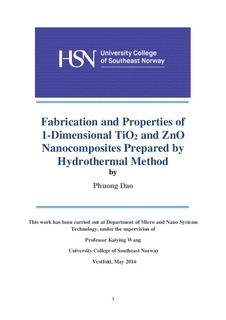| dc.description.abstract | The necessary of renewable energies as the replacement for fossil fuel such as fuel gas from CO2 or hydrogen from photoelectrochemical water splitting process are feasible by using semiconductors as photocatalysts. Among many photocatalytic candidates, titanium dioxide and zinc oxide are the most widely investigated and the most suitable for industrial scale applications due to their attractive physical and chemical properties. In this work, we report the synthesis and photocatalytic properties of silicon doped TiO2 nanotubes (TNTs) and the composite of silicon dioxide and gold layer on ZnO nanorods arrays simply by hydrothermal method.
The diameter of the TiO2 nanotubes is about 20 nm with several micrometers in length and dopant (Si/(Si+Ti)) molar ratio in range of 1~30%. X-ray diffraction analysis verifies formation of nanocrystalline anatase phase for both pristine and Si-doped TNTs. The light absorption spectra of doped TNTs exhibit red shift from 375 nm to 410 nm as compared with that of the un-doped TNTs. Photodegradation experiment shows that this red-shift of spectra absorption is desirable for the redox reaction under relatively long wavelength light illumination.
The morphology of ZnO nanorods array is quite uniform with the rod length in range of 12 micrometers and the rod diameter in range of several hundred micrometers. UV-vis absorption spectra of SiO2 coated ZnO nanorods performs the red shift and the results from photodegradation test indicate a slight increase in the photocatalytic activity of SiO2 coated ZnO nanorods compared to the pristine one. When incorporating SiO2 onto Au-ZnO nanorods plasmonic structure, a great enhancement in photocurrent and a rapid photoresponse were observed. This unique structure is favorable for high performance of photoelectrochemical water splitting.
This work elucidates the economic and efficient hydrothermal pathway to produce nanostructure of photocatalyst. By further modification, both TiO2 nanotubes and ZnO nanorods array shows a promising potential as photocatalyst. | nb_NO |
